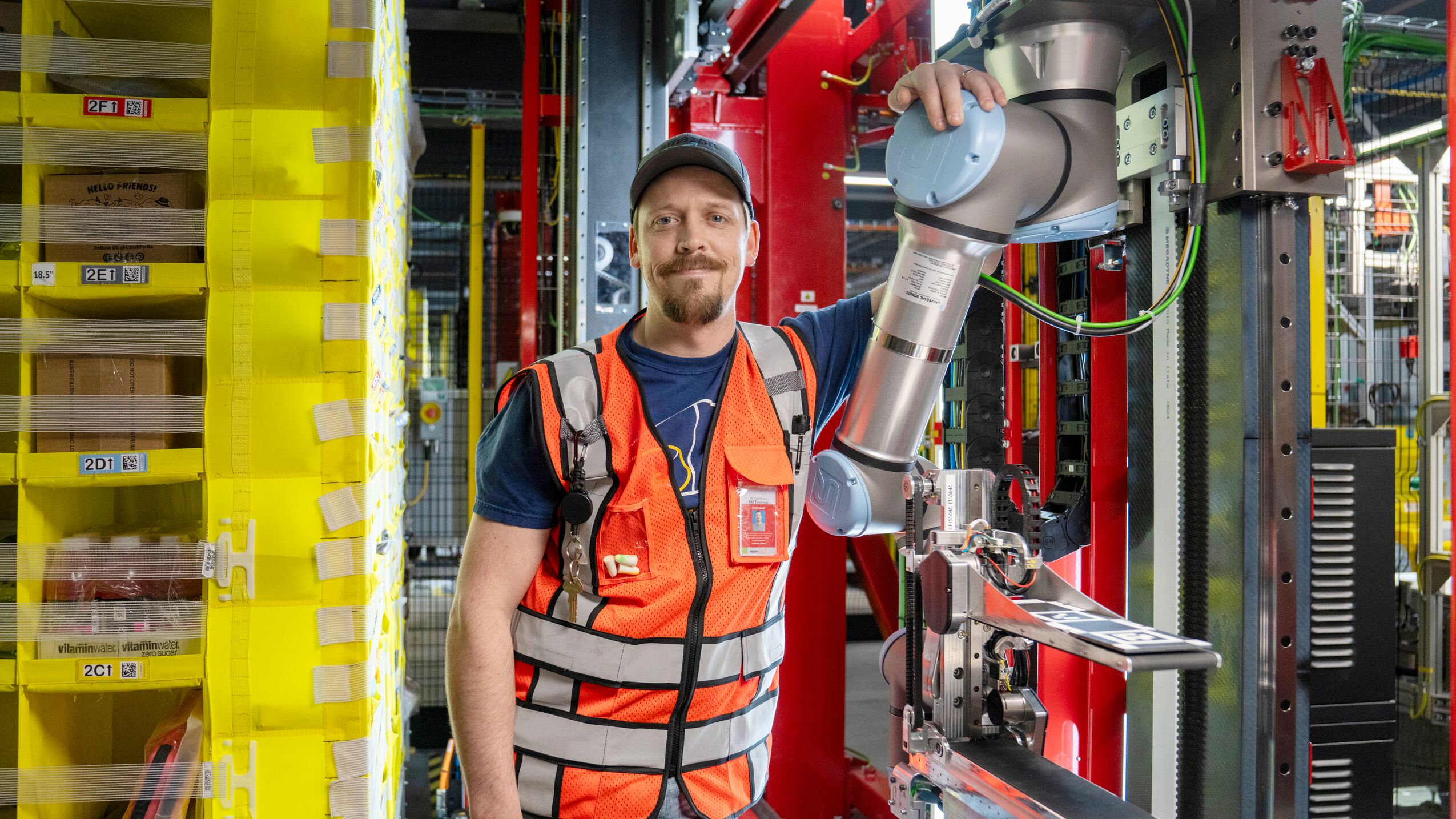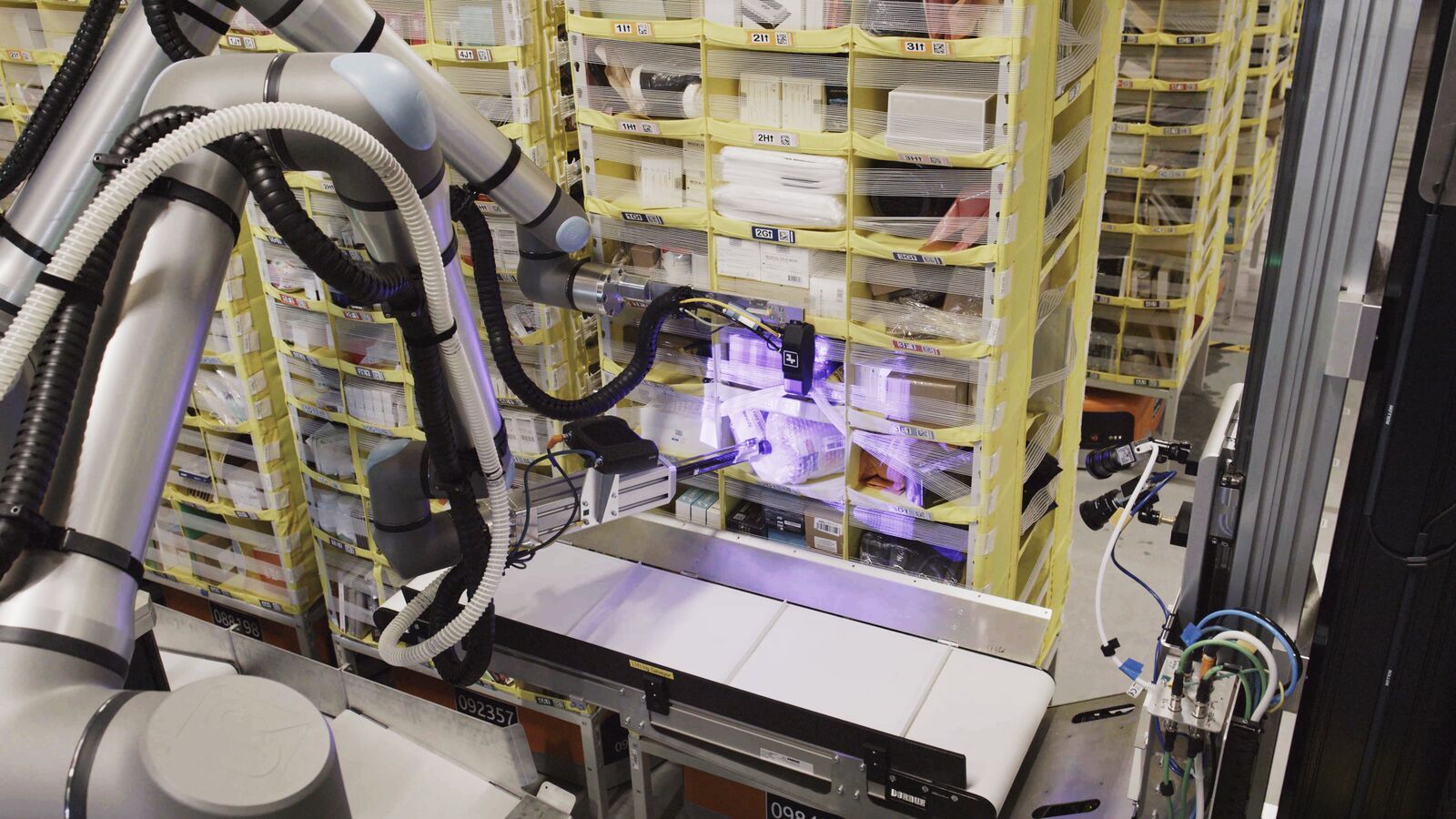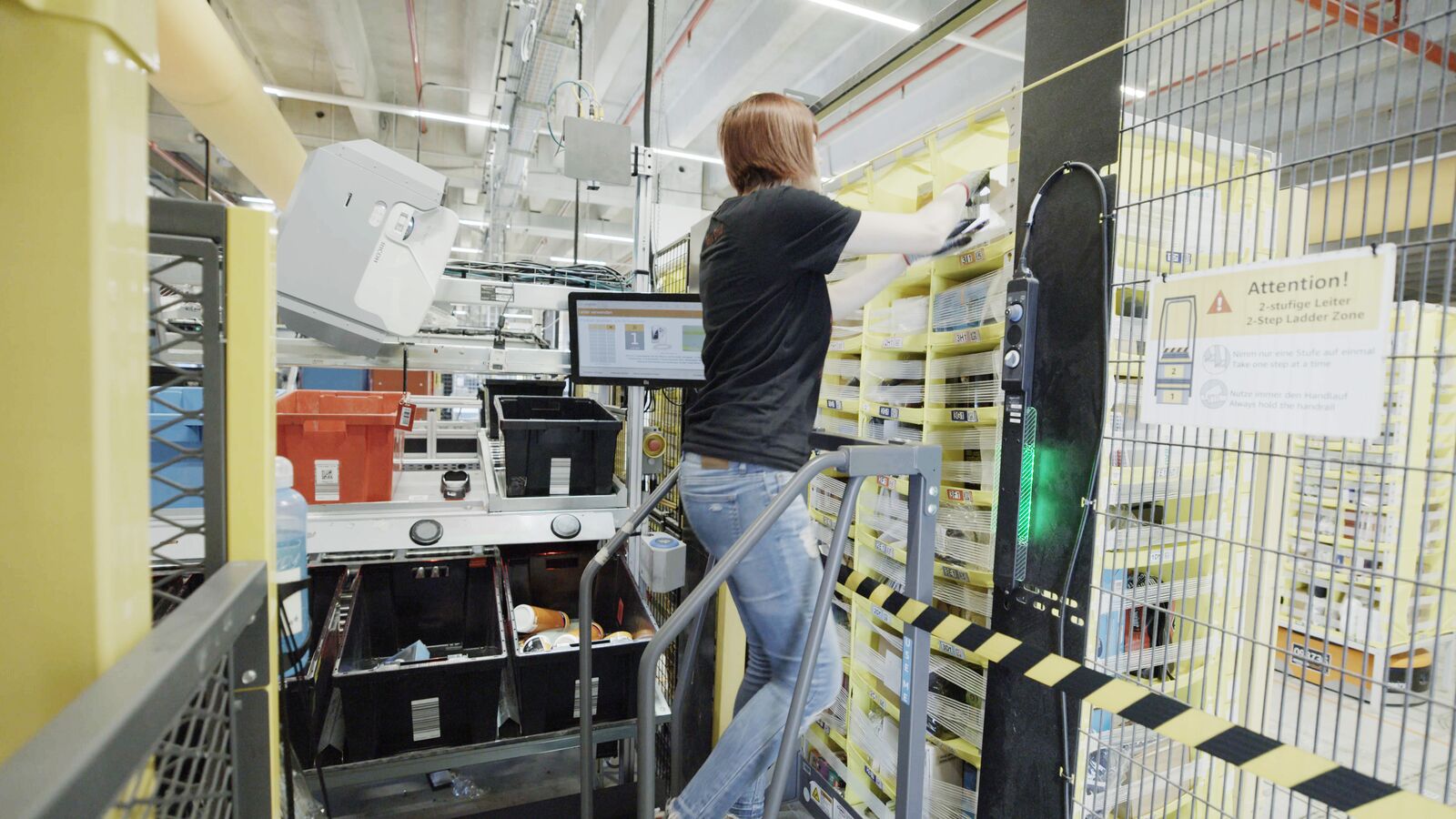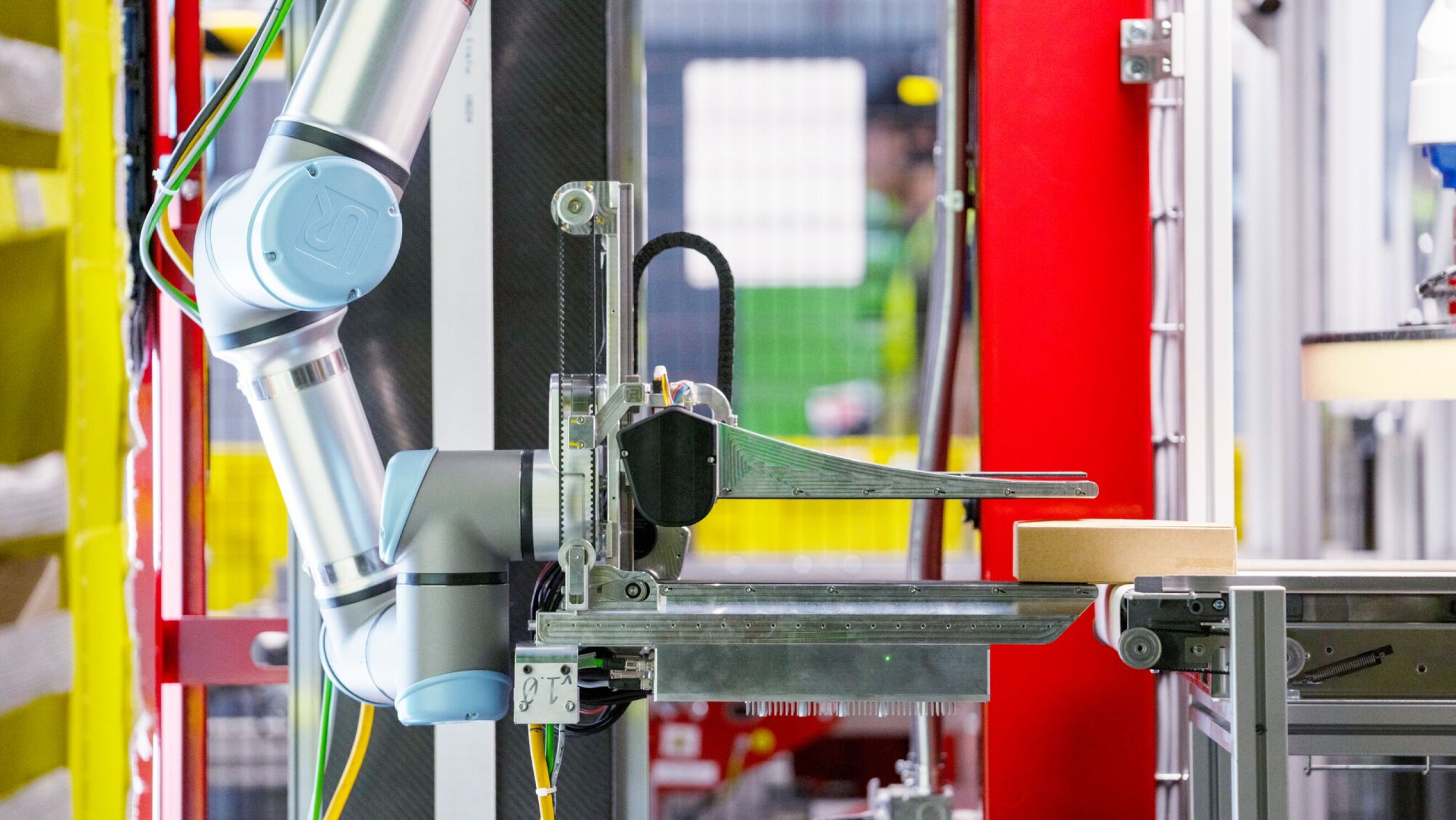The next time you drop a coin on the ground, consider how you go about picking it up again. You rely on your sense of touch to know exactly when to clasp your fingers together and how to flip it into your palm or your pocket—but what many humans do so easily, few robots can tackle.
The typical robot is “numb and dumb,” says Aaron Parness, Amazon’s director of robotics AI, especially those that work in commercial settings. “In the past, when industrial robots have unexpected contact, they either emergency stop or smash through that contact. They often don’t even know they have hit something because they cannot sense it.”
 Vulcan's ability to pick and stow items makes our associates' jobs easier—and our operations more efficient.
Vulcan's ability to pick and stow items makes our associates' jobs easier—and our operations more efficient. At our Delivering the Future event in Dortmund, Germany, we’re introducing a robot that is neither numb nor dumb. Built on key advances in robotics, engineering, and physical AI, Vulcan is our first robot with a sense of touch.
"Vulcan represents a fundamental leap forward in robotics," Parness says. "It's not just seeing the world, it's feeling it, enabling capabilities that were impossible for robots until now."
And it’s already changing the way we operate our fulfilment centres, helping making our employee’s jobs safer and easier while moving customers’ orders more efficiently.
How does Vulcan work?
Vulcan is not our first robot that can pick things up, but with its sense of touch—its ability to understand when and how it makes contact with an object—Vulcan unlocks new ways to improve our operations jobs and facilities.

Just like a human, it can manipulate objects within storage compartments to make room for whatever it’s stowing, because it knows when it makes contact and how much force it’s applying and can stop short of doing any damage. Where a human does this with opposable thumbs and fingers full of sensory receptors, Vulcan uses an “end of arm tooling” (what you might call a hand) that resembles a ruler stuck onto a hair straightener.
The ruler bit pushes around the items already in those compartments to make room for whatever it wants to add. The arms of the hair straightener (the “paddles”) hold the item to be added, adjusting their grip strength based on the item’s size and shape, then use built-in conveyor belts to move the item into the bin.

For picking items from those compartments, Vulcan uses an arm that carries a camera and a suction cup. The camera looks at the compartment and picks out the item to be grabbed, along with the best spot to hold it by. While the suction cup grabs it, the camera watches to make sure it took the right thing and only the right thing.
With those skills, Vulcan can currently handle about three quarters of the millions of products we offer. It also has the ability to identify when it can’t move a specific item, and can ask a human partner to tag in.
 Vulcan uses an arm that carries a camera and a suction cup to pick items from our storage pods.
Vulcan uses an arm that carries a camera and a suction cup to pick items from our storage pods.Vulcan works alongside humans while creating career opportunities
We did all this work to improve not just efficiency, but worker safety and ergonomics. At our fulfilment centres in Spokane, Washington and Hamburg, Germany, Vulcan is already at work picking and stowing inventory in the top rows of those inventory pods. Because those rows are about eight feet up, they typically require an employee to reach them using a step ladder, a process that’s time-consuming, tiring, and one that is less ergonomic than stowing and picking at their midriff. Vulcan also handles items stowed just above the floor, so our associates can work where they’re most comfortable.
“Vulcan works alongside our employees, and the combination is better than either on their own,” says Parness.
 Vulcan will let our associates spend less time on step ladders and more time working in their power zone.
Vulcan will let our associates spend less time on step ladders and more time working in their power zone. This application of Vulcan’s capabilities is just the latest example of how we think about and use this kind of technology. Over the past dozen years, we’ve deployed more than 750,000 robots into our fulfilment centres, all of them designed to help our employees work safely and efficiently by taking on physically taxing parts of the fulfilment process.
Meanwhile, these robots—which play a role in completing 75% of customer orders—have created hundreds of new categories of jobs at Amazon, from robotic floor monitor to onsite reliability maintenance engineers. We also offer training programmes like Career Choice, which help our associates move into robotics and other high-tech fields.
How Vulcan uses physical AI to feel the real world
Vulcan even learns from its own failures, figuring out how different objects behave when touched and steadily building up an understanding of the physical world, just like kids do. So, you can expect it to become smarter and more capable in the years to come.
The result, Parness says, is “a technology that three years ago seemed impossible but is now set to help transform our operations.”
 Vulcan represents “a technology that three years ago seemed impossible but is now set to help transform our operations," says Aaron Parness, Amazon’s director of robotics AI.
Vulcan represents “a technology that three years ago seemed impossible but is now set to help transform our operations," says Aaron Parness, Amazon’s director of robotics AI.Where is Vulcan being used?
That transformation is on its way not just because Vulcan’s so capable, but because we implement our best work at Amazon scale. We plan to deploy Vulcan systems over the next couple of years at sites throughout Europe, the United Kingdom, and the United States.
“Our vision is to scale this technology across our network, enhancing operational efficiency, improving workplace safety, and supporting our employees by reducing physically demanding tasks,” Parness says. Better operational efficiency translates to getting the right product to right truck at ever faster speeds, allowing us to continue widening our selection and offer industry-leading prices.
And all it took was teaching a robot to feel.

